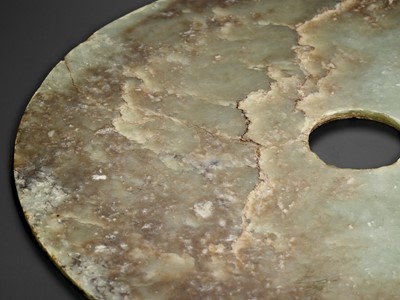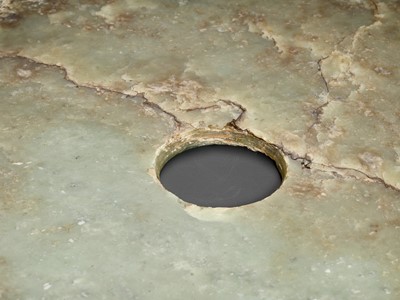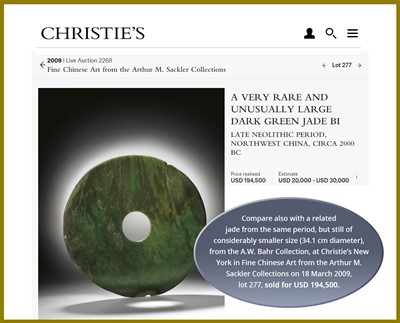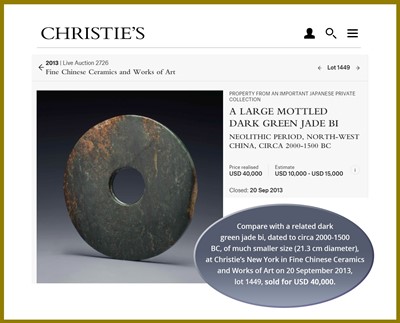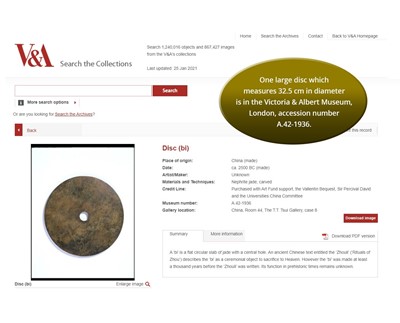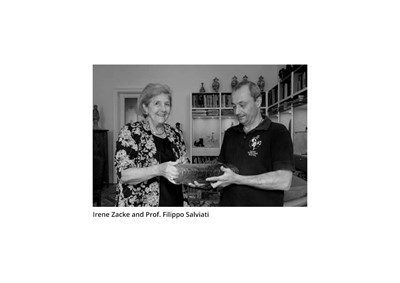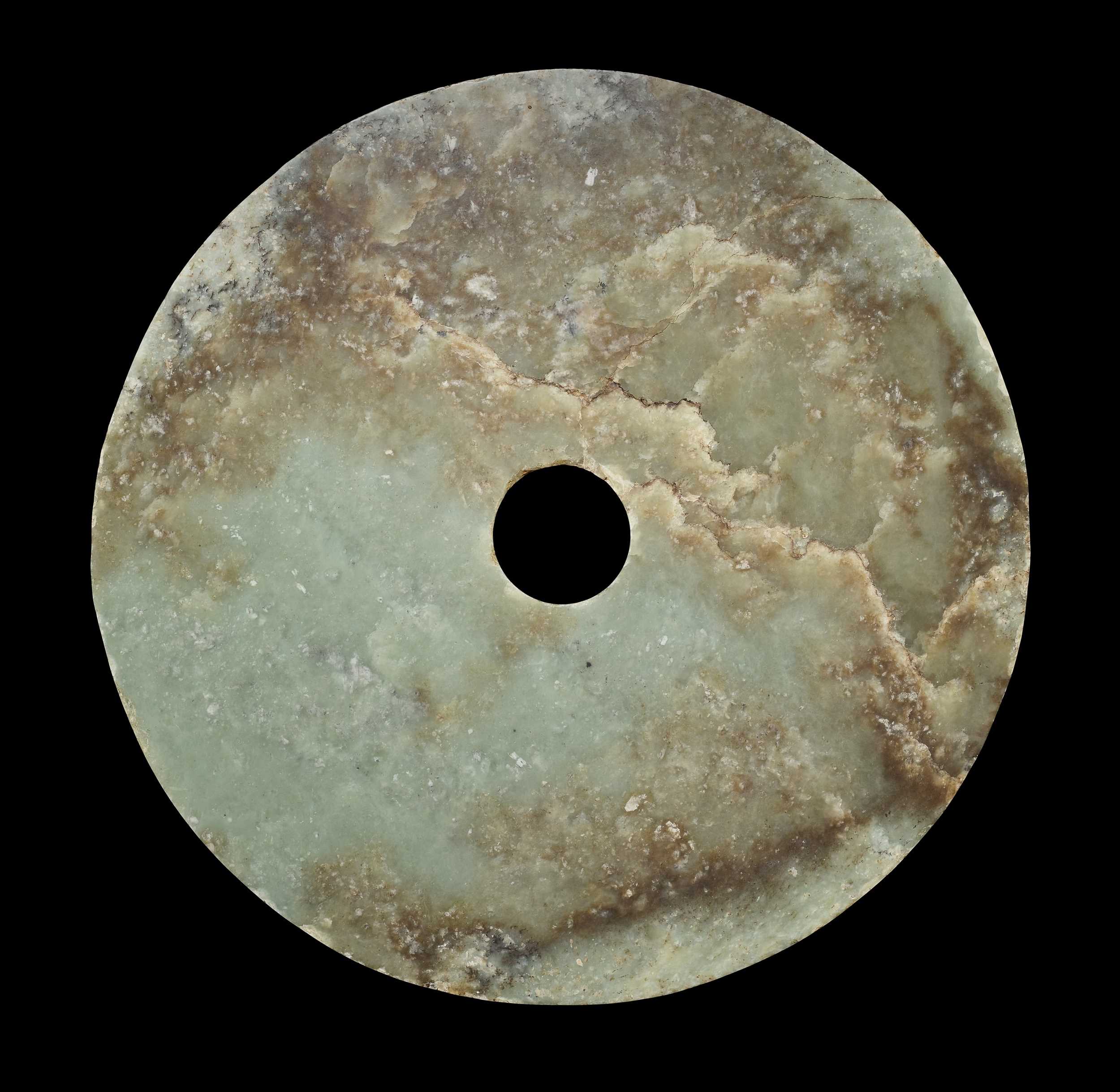5th Mar, 2021 10:00
TWO-DAY AUCTION - Fine Chinese Art / 中國藝術集珍 / Buddhism & Hinduism
61
AN EXCEPTIONALLY LARGE PALE GREEN AND RUSSET JADE BI DISC, EARLY BRONZE AGE
青銅時代大型青玉璧
Sold for €7,584
including Buyer's Premium
China, c. 2200-1900 BC. Of somewhat irregular thickness and still retaining the cutting marks on the walls of the central hole drilled from both sides, the mostly translucent stone of variegated shades of green ranging from pale olive to sea-green with some russet-brown veining and shadings as well as cloudy white inclusions.
Provenance: The Collection of Irene and Wolfgang Zacke. The couple have been active in the art trade for well over half a century and were one of the first in Austria to offer Asian works of art for sale, starting in 1968. Since the late 1980s, they have been collecting ancient Chinese jades, building an extensive collection over the decades.
Published: 4000 Years of Chinese Archaic Jades, Prof. Filippo Salviati, 2017, page 96, no. 109.
Condition: Excellent condition with old wear, signs of weathering, nibbling and some losses to edges, the stone with natural fissures, some of which have developed into larger hairline cracks over time. Some traces of use and shallow surface scratches.
Weight: 3,814 g
Dimensions: Diameter 43.5 cm
Bi discs are a type of jade which continued to be crafted in numbers by cultures located in central and northwest China during the transitional period between the Neolithic and Bronze Age. The majority of these discs range in size between ten and twenty centimeters: large ones, such as the present lot, are rare. Their size and weight, requiring both hands to hold them, suggest that these imposing discs were displayed and used in a ritual context. The hole is usually drilled from one side only: on larger discs, it is smoothed down and the traces of the tool marks are almost invisible.
The whitened areas are mostly limited to the edges. This alteration, which is often seen on excavated jades, was probably created by the action of alkaline body fluids on the nephrite.
Literature comparison: A related green jade bi of smaller size (22 cm diameter) is illustrated by J. Rawson, Chinese Jade from the Neolithic to the Qing, British Museum, 1995, p. 155, no. 7:6, where the author ascribes it to northwest China, c. 2000-1000 BC. One large disc which measures 32.5 cm in diameter is in the Victoria & Albert Museum, London, accession number A.42-1936.
Auction result comparison: Compare with a related dark green jade bi, dated to circa 2000-1500 BC, of much smaller size (21.3 cm diameter), at Christie’s New York in Fine Chinese Ceramics and Works of Art on 20 September 2013, lot 1449, sold for USD 40,000. Compare also with a related jade from the same period, but still of considerably smaller size (34.1 cm diameter), from the A.W. Bahr Collection, at Christie’s New York in Fine Chinese Art from the Arthur M. Sackler Collections on 18 March 2009, lot 277, sold for USD 194,500.
青銅時代大型青玉璧
中國,公元前2200-1900 年。厚度不規則,保留著切割痕跡,主體半透明,夾雜著不同深淺的綠色,從淺橄欖色到海綠色,帶有紅褐色的紋理,以及絮狀物。
來源:Irene 與Wolfgang Zacke收藏。這對夫妻一直活躍於藝術品行業已有半個多世紀,自1968年起他們開始在奧地利經營亞洲藝術品,是最早的商人之一。自1980年代後期以來,他們一直在收集中國古玉,數十年來建立了一個大規模的收藏。
圖片:Irene Zacke 與 Prof. Filippo Salviati教授
出版:4000 Years of Chinese Archaic Jades, Prof. Filippo Salviati, 2017, page 96, no. 109.
品相:狀況良好,有舊磨損,風化,一些邊緣磨損,輕微使用痕跡和表面淺痕,帶有天然裂紋的玉石,隨著時間的流逝,其中一些可能會發展成細小的裂縫。
重量:3,814 克
尺寸:直徑43.5 厘米
拍賣結果比較:一件相近墨綠玉璧,公元前 2000-1500年, 尺寸更小 (直徑21.3 厘米), 見紐約佳士得Fine Chinese Ceramics and Works of Art 拍場2013年9月20 日 lot 1449, 售價USD 40,000. 一件來自同一時期但尺寸更小(直徑34.1 厘米)的玉璧,來自A.W. Bahr 收藏, 見紐約佳士得Fine Chinese Art from the Arthur M. Sackler Collections 拍場2009年3月18日 lot 277, 售價USD 194,500.
China, c. 2200-1900 BC. Of somewhat irregular thickness and still retaining the cutting marks on the walls of the central hole drilled from both sides, the mostly translucent stone of variegated shades of green ranging from pale olive to sea-green with some russet-brown veining and shadings as well as cloudy white inclusions.
Provenance: The Collection of Irene and Wolfgang Zacke. The couple have been active in the art trade for well over half a century and were one of the first in Austria to offer Asian works of art for sale, starting in 1968. Since the late 1980s, they have been collecting ancient Chinese jades, building an extensive collection over the decades.
Published: 4000 Years of Chinese Archaic Jades, Prof. Filippo Salviati, 2017, page 96, no. 109.
Condition: Excellent condition with old wear, signs of weathering, nibbling and some losses to edges, the stone with natural fissures, some of which have developed into larger hairline cracks over time. Some traces of use and shallow surface scratches.
Weight: 3,814 g
Dimensions: Diameter 43.5 cm
Bi discs are a type of jade which continued to be crafted in numbers by cultures located in central and northwest China during the transitional period between the Neolithic and Bronze Age. The majority of these discs range in size between ten and twenty centimeters: large ones, such as the present lot, are rare. Their size and weight, requiring both hands to hold them, suggest that these imposing discs were displayed and used in a ritual context. The hole is usually drilled from one side only: on larger discs, it is smoothed down and the traces of the tool marks are almost invisible.
The whitened areas are mostly limited to the edges. This alteration, which is often seen on excavated jades, was probably created by the action of alkaline body fluids on the nephrite.
Literature comparison: A related green jade bi of smaller size (22 cm diameter) is illustrated by J. Rawson, Chinese Jade from the Neolithic to the Qing, British Museum, 1995, p. 155, no. 7:6, where the author ascribes it to northwest China, c. 2000-1000 BC. One large disc which measures 32.5 cm in diameter is in the Victoria & Albert Museum, London, accession number A.42-1936.
Auction result comparison: Compare with a related dark green jade bi, dated to circa 2000-1500 BC, of much smaller size (21.3 cm diameter), at Christie’s New York in Fine Chinese Ceramics and Works of Art on 20 September 2013, lot 1449, sold for USD 40,000. Compare also with a related jade from the same period, but still of considerably smaller size (34.1 cm diameter), from the A.W. Bahr Collection, at Christie’s New York in Fine Chinese Art from the Arthur M. Sackler Collections on 18 March 2009, lot 277, sold for USD 194,500.
青銅時代大型青玉璧
中國,公元前2200-1900 年。厚度不規則,保留著切割痕跡,主體半透明,夾雜著不同深淺的綠色,從淺橄欖色到海綠色,帶有紅褐色的紋理,以及絮狀物。
來源:Irene 與Wolfgang Zacke收藏。這對夫妻一直活躍於藝術品行業已有半個多世紀,自1968年起他們開始在奧地利經營亞洲藝術品,是最早的商人之一。自1980年代後期以來,他們一直在收集中國古玉,數十年來建立了一個大規模的收藏。
圖片:Irene Zacke 與 Prof. Filippo Salviati教授
出版:4000 Years of Chinese Archaic Jades, Prof. Filippo Salviati, 2017, page 96, no. 109.
品相:狀況良好,有舊磨損,風化,一些邊緣磨損,輕微使用痕跡和表面淺痕,帶有天然裂紋的玉石,隨著時間的流逝,其中一些可能會發展成細小的裂縫。
重量:3,814 克
尺寸:直徑43.5 厘米
拍賣結果比較:一件相近墨綠玉璧,公元前 2000-1500年, 尺寸更小 (直徑21.3 厘米), 見紐約佳士得Fine Chinese Ceramics and Works of Art 拍場2013年9月20 日 lot 1449, 售價USD 40,000. 一件來自同一時期但尺寸更小(直徑34.1 厘米)的玉璧,來自A.W. Bahr 收藏, 見紐約佳士得Fine Chinese Art from the Arthur M. Sackler Collections 拍場2009年3月18日 lot 277, 售價USD 194,500.
Zacke Live Online Bidding
Our online bidding platform makes it easier than ever to bid in our auctions! When you bid through our website, you can take advantage of our premium buyer's terms without incurring any additional online bidding surcharges.
To bid live online, you'll need to create an online account. Once your account is created and your identity is verified, you can register to bid in an auction up to 12 hours before the auction begins.
Intended Spend and Bid Limits
When you register to bid in an online auction, you will need to share your intended maximum spending budget for the auction. We will then review your intended spend and set a bid limit for you. Once you have pre-registered for a live online auction, you can see your intended spend and bid limit by going to 'Account Settings' and clicking on 'Live Bidding Registrations'.
Your bid limit will be the maximum amount you can bid during the auction. Your bid limit is for the hammer price and is not affected by the buyer’s premium and VAT. For example, if you have a bid limit of €1,000 and place two winning bids for €300 and €200, then you will only be able to bid €500 for the rest of the auction. If you try to place a bid that is higher than €500, you will not be able to do so.
Online Absentee and Telephone Bids
You can now leave absentee and telephone bids on our website!
Absentee Bidding
Once you've created an account and your identity is verified, you can leave your absentee bid directly on the lot page. We will contact you when your bids have been confirmed.
Telephone Bidding
Once you've created an account and your identity is verified, you can leave telephone bids online. We will contact you when your bids have been confirmed.
Classic Absentee and Telephone Bidding Form
You can still submit absentee and telephone bids by email or fax if you prefer. Simply fill out the Absentee Bidding/Telephone bidding form and return it to us by email at office@zacke.at or by fax at +43 (1) 532 04 52 20. You can download the PDF from our Upcoming Auctions page.
How-To Guides
How to Create Your Personal Zacke Account
How to Register to Bid on Zacke Live
How to Leave Absentee Bids Online
How to Leave Telephone Bids Online
中文版本的操作指南
创建新账号
注册Zacke Live在线直播竞拍(免平台费)
缺席投标和电话投标
Third-Party Bidding
We partner with best-in-class third-party partners to make it easy for you to bid online in the channel of your choice. Please note that if you bid with one of our third-party online partners, then there will be a live bidding surcharge on top of your final purchase price. You can find all of our fees here. Here's a full list of our third-party partners:
- 51 Bid Live
- EpaiLive
- ArtFoxLive
- Invaluable
- LiveAuctioneers
- the-saleroom
- lot-tissimo
- Drouot
Please note that we place different auctions on different platforms. For example, in general, we only place Chinese art auctions on 51 Bid Live.
Bidding in Person
You must register to bid in person and will be assigned a paddle at the auction. Please contact us at office@zacke.at or +43 (1) 532 04 52 for the latest local health and safety guidelines.


